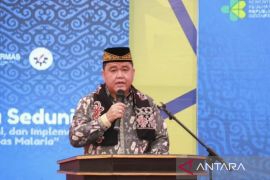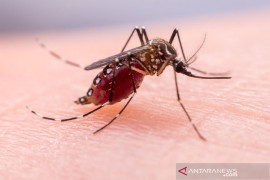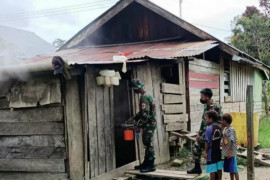Malaria is a mosquito-borne infectious disease in humans caused by eukaryotic protists of the genus Plasmodium, that is widespread in tropical and subtropical regions, including much of Sub-Saharan Africa, Asia and the Americas.
The disease results from the multiplication of malaria parasites within red blood cells, causing symptoms that typically include fever and headache, in severe cases progressing to coma, and death.
World Malaria Day on April 25 is dedicated to the global efforts to control malaria, and this year?s theme is Achieving Progress and Impact - heralds the international community`s renewed efforts make progress towards zero malaria deaths by 2015.
Malaria eradication stakeholders will continue to report on the remaining challenges to reach the 2010 target of universal coverage of malaria treatment and prevention, as called for by the UN Secretary-General, Ban Ki-moon.
World Malaria Day represents a chance for all of us to make a difference from any levels such as government, company, charity or individual to roll back malaria and help generate broad gains in health and human development.
Reducing the malaria impact is the key of the Millennium Development Goals (MDGs) achievement, agreed by every United Nations Member State.
According to the Indonesian Health Ministry`s Director General of Disease Control and Environmental Health (P2PL) Prof dr Tjandra Yoga Aditama, Malaria is known to be highly endemic in African continent especially for the Plasmodium Falciparum variant, Central and South Asia region also considered to be the second highest after Africa, the disease can also be found in Central America such as the Amazone area.
Recently there are 10 countries reported with highest malaria rate due to the population density which made great infectious potentials such as China, Indonesia, Bangladesh, Pakistan, Nigeria, Vietnam, Thailand (at Delta Mekong area), Congo and the Philippines.
In European countries and the United States of America, malaria has been successfully eradicated due to the invention of DDT (Dichloro Diphenyl Trichloroethane) insecticide in 1939 and the quinine drug for malaria, both were seriously fighting the disease since then and now the areas are malaria free.
Besides, the Europe and The USA have also done some engineering on environmental sanitation and drainage restoration, canal building (Panama Canal), and enough malaria eradication funds.
Factors That Hampers Malaria Eradication Efforts
"In Indonesia, Malaria still becomes a health concerning issue especially for areas outside Java and Bali Island such as the eastern part of Indonesia. Malaria eradication effort has been increased all over Indonesia by the intensification of active case detection using the Mass Body Survey (MBS) and Mass Fever Survey (MFS),"Tjandra said.
According to the Indonesian Health Ministry, malaria endemicity is divided in three parts, the highest endemicity is in the eastern part of Indonesia, medium endemicity in Sumatra, Kalimantan and Sulawesi, low endemicity is in Java and Bali.
Malaria endemicity in Indonesia is divided in several areas based on Annual Parasite Incident (API: confirmed cases during one year per population under surveillance times 1000) namely the relatively free of malaria (Greater Jakarta and Bali), low endemic area consisted on pocketing areas in Southern part of Java Island, medium endemicity in Sumatra, Kalimantan and Maluku islands.
For the high Malaria endemicity areas consisting of West Nusa Tenggara (NTB) with 20 cases of 1000 citizen is the lowest than, East Nusa Tenggara (NTT) and Maluku`s city that ranging at 20-50 cases, and the highest endemic is in Maluku, North Maluku and Papua for more than 50 cases.
There are factors in African and Asian countries that hamper malaria eradication efforts, such as environmental destruction which caused widespread of mosquito breeding places, people movement to work from a non-endemic to malaria endemic area, economic crisis and limited funds in these countries causes a lack of resources (energy, infrastructure, operational costs, etc.), poverty and lack of nutrients that causes poor immune system.
Therefore malaria in Indonesia still have to be concerned because of population migration from high or low endemic areas or the contrary, there are environmental changes such as deforestation, excavation of sand, ponds, plantation (oil palm, rubber, bark, etc.) and agriculture with irrigation system the less good.
Besides, there are reported of anti-malarial drug resistance, resistance to insecticides cases. There are also socioeconomic factors such as poverty, ignorance and financial factors for malaria control completely, difficult geographical factors and the availability of funds and health facilities to disadvantaged, border and island areas.
"Recently, we can reach the remote areas thanks to the cooperation of the Regional Health Offices and the NGO's (Perdhaki Aisyaj, NU, Muhammadiyah, etc.), but we still couldn?t reach the disadvantage, border and isles areas," Tjandra said in responding to the Indonesian geographical barriers that hampers the effort.
Other factors are caused from human behaviour and factors beyond the government`s commitment to the health sector.
Since the MDGs (Millennium Development Goals) stipulation in 1990, the reported clinical case is numbering about 6 million cases, even in a Health Ministry?s Research and Development survey by 2001 to be around 15 million cases.
With the implementation of malaria control programs in Indonesia, then from year to year the reported case is declining, clinical malaria cases from three million in the year 2000 to 1.8 million cases in 2006.
Currently, the Ministry of Health is ensuring that all clinical cases or suspected cases coordinated with the blood supply examination, microscope or using a Rapid Diagnostic Test (RDT).
From year to year the blood supply percentage increases which confirmed from about 40 percent to 70 percent, while for the Java-Bali region is almost 100 percent of malaria cases have been confirmed clear.
By the Malaria Elimination commitment the Ministry will continue to pursue early malaria cases and treated promptly so that it can achieve the MDGs indicators of API one per thousand citizen in 2014.
Malaria Symptoms and its Drugs
Malaria clinical symptoms that arise in a person may vary, depending on the type of the infecting parasite, starting from no symptoms at all until the classic severe symptoms and death.
Malaria parasite of Plasmodium Falciparum (known as the Tropicana Malaria) is likely to cause complications or severe symptoms such as fever every 24-48 hours, where the Plasmodium Vivax causes fever on the 3rd infectious day, and there are other rare Malaria parasite types such as the Plasmodium Malariae and Ovale.
Once the disease is treated, Plasmodium Falciparum can relapse in about eight weeks after an incomplete initial treatment due to the drugs is not completely eliminate the parasite.
The Plasmodium Vivax parasite is tricky because it can hide inside a person?s hearts and become a latent which one day could recur approximately after 24 weeks and can recur over and over again until 3-4 years period.
Plasmodium Vivax is very difficult to cure, especially when the Anti-Malaria Drugs plus Primaquin not be taken as directed, usually because the patients stop treatment when it was cured.
According to Tjandra, the anti malarial drugs used as first-line today in Indonesia is the artemisinin-based combination therapy (ACT) type artesunat amodiakuin and dehydro artemsinin Piperaquin added with primaquine.
These drugs can only be used for one day only to treat Plasmodium Falciparum, but for Plasmodium Vivax treatment might need 14 days to make sure all parasites are killed and end the transmission chain, Tjandra said.
"If the ACT drugs are not available, quinine (KINA) pills can be used for trimester old pregnant women or for those still cannot be cures after taking ACT drugs," he said.(*)
Reporter: Ageng Wibowo Leksono
Editor: Aditia Maruli Radja
Copyright © ANTARA 2011











